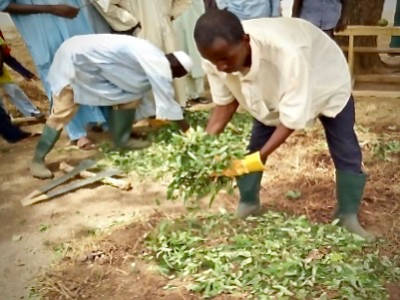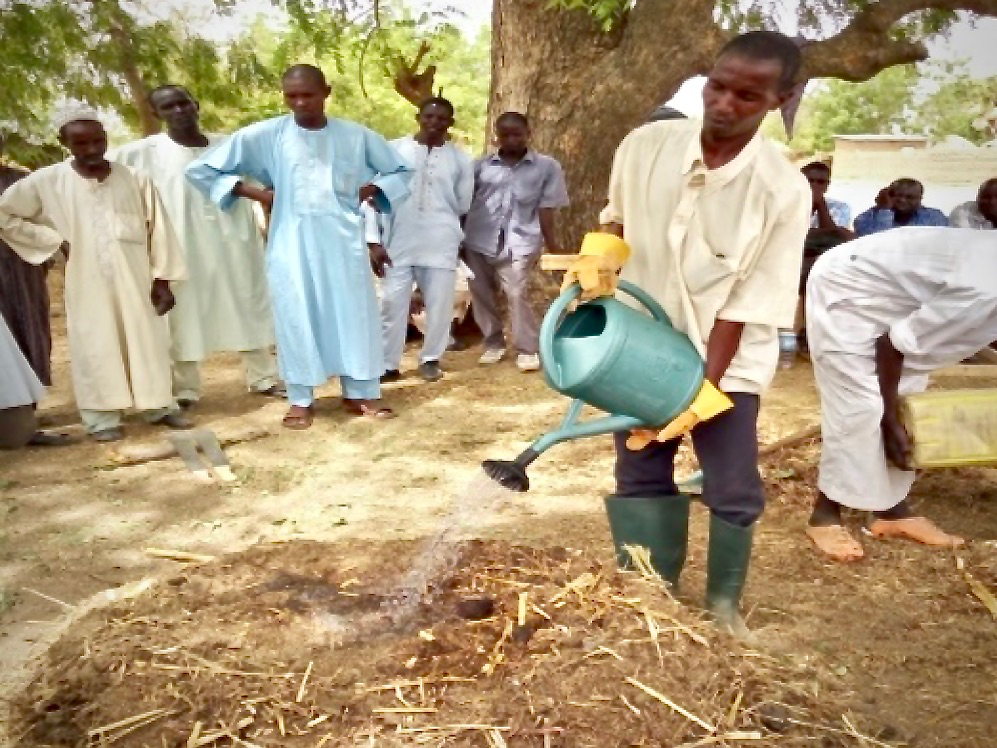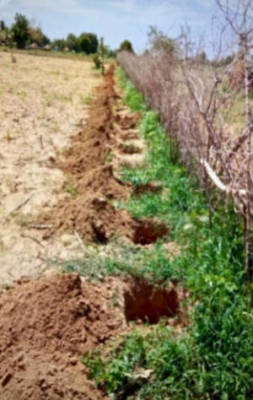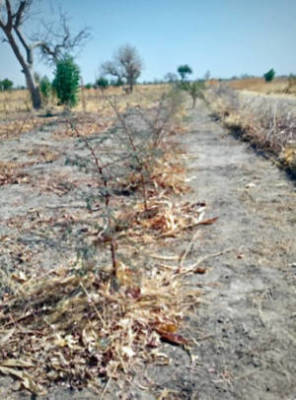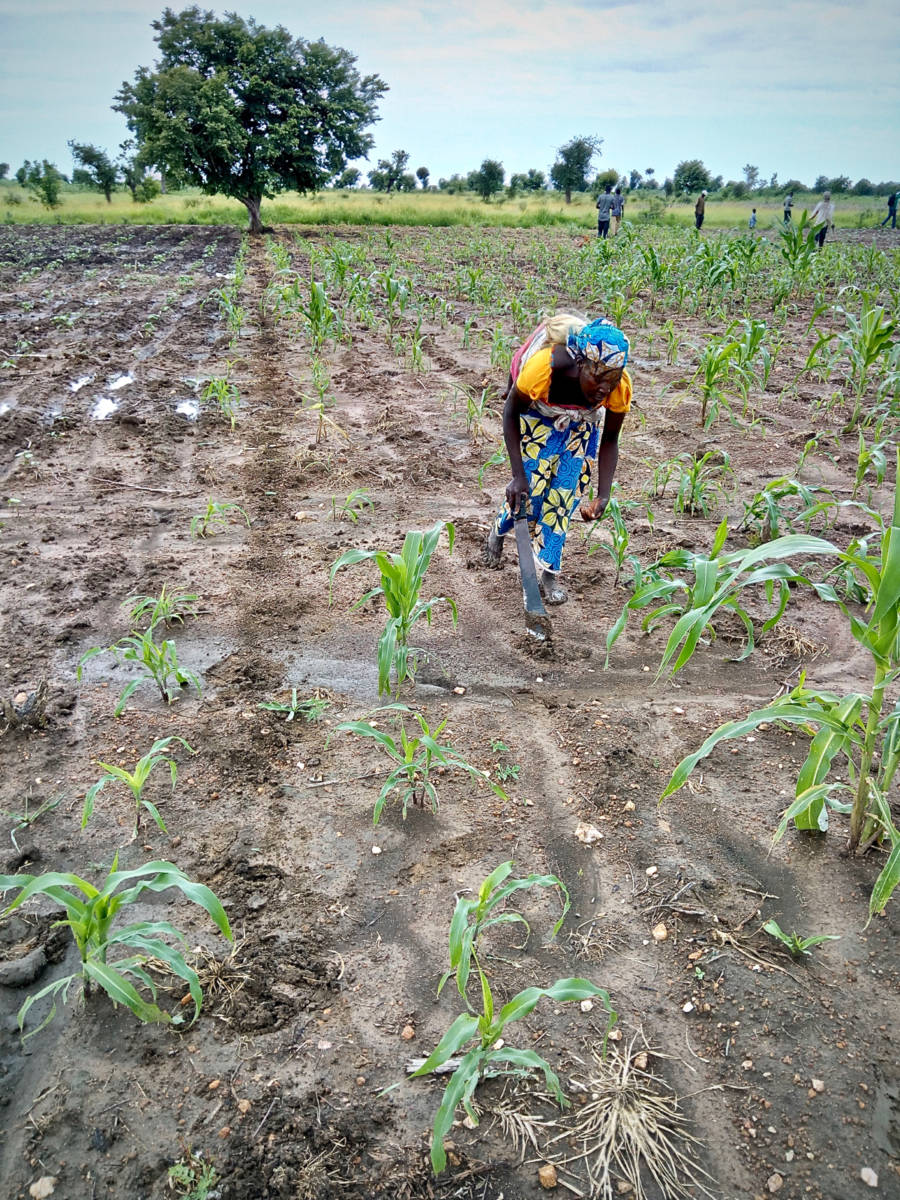Utilizing Local Know-How for Soil Rehabilitation in Dry Areas
The case of Laf and Maoudine in the Far-North Region of Cameroon
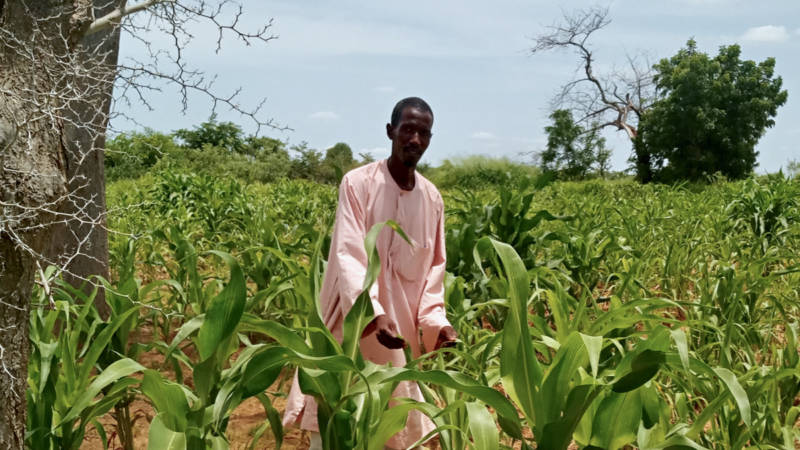
A leading farmer in his plot in Maoudine
Deforestation and land degradation are thorny issues for the planet today and Africa is no exception. According to FAO (2016) and UNEP (2013), the continent is losing about 2.8 million hectares of forest per year, with nearly 50 million hectares of land affected by degradation. As Africa’s climate changes, the sectors that use the land are greatly affected by rising temperatures and sea levels or irregular rainfall. This situation is forcing farmers more and more to adopt their crops and livestock management as a matter of urgency, given this new pressure on water and the decline in agricultural productivity (Global Forest Landscapes, 2018).
Unlike forest degradation, which refers to the reduction of forests’ capacity to provide goods and services, land degradation is generally defined as a “persistent decline” in ecosystem goods and services, including biological goods and services related to water, and social and economic goods and services related to land. It is therefore influenced by natural and socio-economic factors (UNCCD, 2016b). Land degradation leads to reduced food production, poor water conservation, loss of biodiversity, loss of soil organic carbon and loss of ecosystem services (IUCN, 2015; Gilbey et al., 2019).
Land degradation is observed in all climatic zones of the planet. It affects about 23% of the earth’s surface and is increasing at an annual rate of 5-10 million hectares (Stavi & Lal, 2015). Land degradation due to human activities has a negative impact on the well-being of at least 3.2 billion people, and costs more than 10% of the world’s annual gross domestic product in lost biodiversity and ecosystem services. The cost of land degradation indirectly affects everyone. The overall economic loss of ecosystem services due to land degradation and desertification has been estimated at US$ 870-1,450 per person per year.
Cameroon, like other developing countries in sub-Saharan Africa, has a population of more than 80% rural (DSCE, 2010), heavily dependent on agricultural production for its livelihood. Agriculture, livestock, fishing and the collection of forest products are the main activities of the majority rural populations. This country is vulnerable to the impacts of climate change (recurrence of droughts, floods, silting of rivers, etc.). MINEPDED, 2015a).
As an attempt to solve this thorny problem, the Government of Cameroon, in the restoration of degraded forest landscapes at the national level, has expressed its interest in participating in the African Forest Landscape Restoration Initiative (AFR 100), with the support of development partners. This approach is in line with the “Bonn challenge” launched in 2015 at COP 21, which aims to restore 150 million hectares worldwide by 2015. The AFR100 initiative, which emerged from this Bonn challenge, has made a commitment to contribute to the restoration of 100 million degraded lands in Africa by 2030.
Cameroon, by marking its adherence to this initiative, has made the second largest commitment in the African continent after Ethiopia, that of restoring 12,062,768 hectares of deforested and degraded forest landscapes at the national level, thus more than 8 million for the northern part of the country, including the Far North Region.
Very often considered as a gateway to the desert, the Far North region of Cameroon is also considered the most populated region in the country after the Central region, according to the report of the last general census in Cameroon. This region has more than 400,000 hectares of highly degraded and abandoned land due to climatic factors but also and above all, human activities and poor land management practices, hence the need to promote sustainable land management. At this rate, millions of people will be directly affected by land degradation with more severe impacts on the poorest segments of the population, in this case women and children, if nothing is done to reverse this trend. With soaring demographics, the increase in food insecurity coupled with the current social insecurity in the Far North region will increase the vulnerability of farmers to land degradation, flooding and drought.
With this in mind, as part of the implementation of the 2016-2019 phase of the ProPFE, the GIZ has set itself the guideline of promoting local know-how in soil restoration, in order to improve the well-being and livelihoods of rural populations.
Materials and method
Study intervention areas
The study was carried out in the localities of Laf and Maoudine, belonging to the Mayo-Kani Department of the Far North region of Cameroon. The aim was to rehabilitate abandoned agricultural plots according to soil types (Table 1).
Table 1: Soil characteristics of the intervention area
| Characteristics | Lateritic soils | Sandy soil |
| pH-H2O (1 :2.5) | 4,5 | 4,1 |
| pH-KCl (1 :2.5) | 4,2 | 3,9 |
| Acidité d’échange (cmol / Kg) | 0,5 | 0,5 |
| Base échangeable (cmol / Kg) | 1,8 | 1,3 |
| Saturation en éléments basiques (%) | 79,0 | 4,1 |
| Saturation en Al (%) | 14,8 | 19,9 |
| Capacité Echange Cationique (cmol / Kg) | 2,3 | 1,8 |
| Azote total (mg /Kg) | 253,2 | 174,9 |
| Phosphore assimilable (mg / Kg) | 5,5 | 14,3 |
| Carbone organique (%) | 0,3 | 0,2 |
| Sable (%) | 74,8 | 96,6 |
| Argile (%) | 25,2 | 3,4 |
Adapted from: Abdousssalam et al., 2017
The characteristics of the two sites are shown in Table 2 below.
Table 2: Main characteristics of the initiative sites

Crop varieties resilient to climate change
The regular crops in the plots of the Leaders Farmers are mainly cereals and legumes (Table 3).
Table 3: Characteristics of producers’ preferred crops and varieties
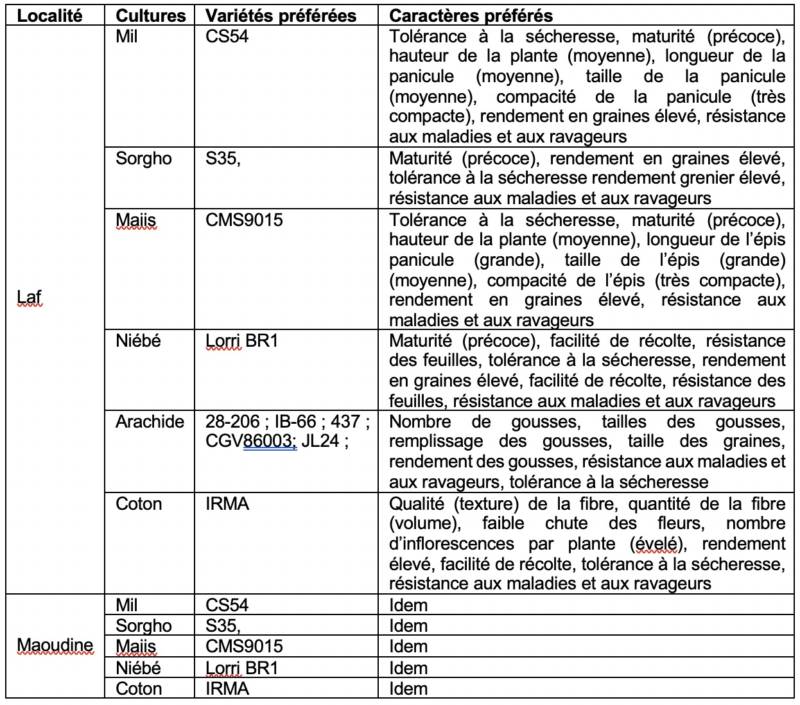
Results
In a participatory manner, awareness and information meetings were held in the various communities. They took into account the opinions of all stakeholders. Participatory and inclusive planning of activities throughout the agricultural season was essential. A series of theoretical and practical training (based on learning by doing) took place. The follow-up of the activities was ensured by Village Animators (or Relay Trainers), skillfully chosen during the meetings, according to their ability to mobilize the populations and to communicate.
Grid of soil rehabilitation techniques in the intervention area
Activity planning included the participatory development of a grid of local know-how on integrated land rehabilitation (fertility) management techniques (Table 4).
Table 4: Table of land rehabilitation techniques in the intervention area
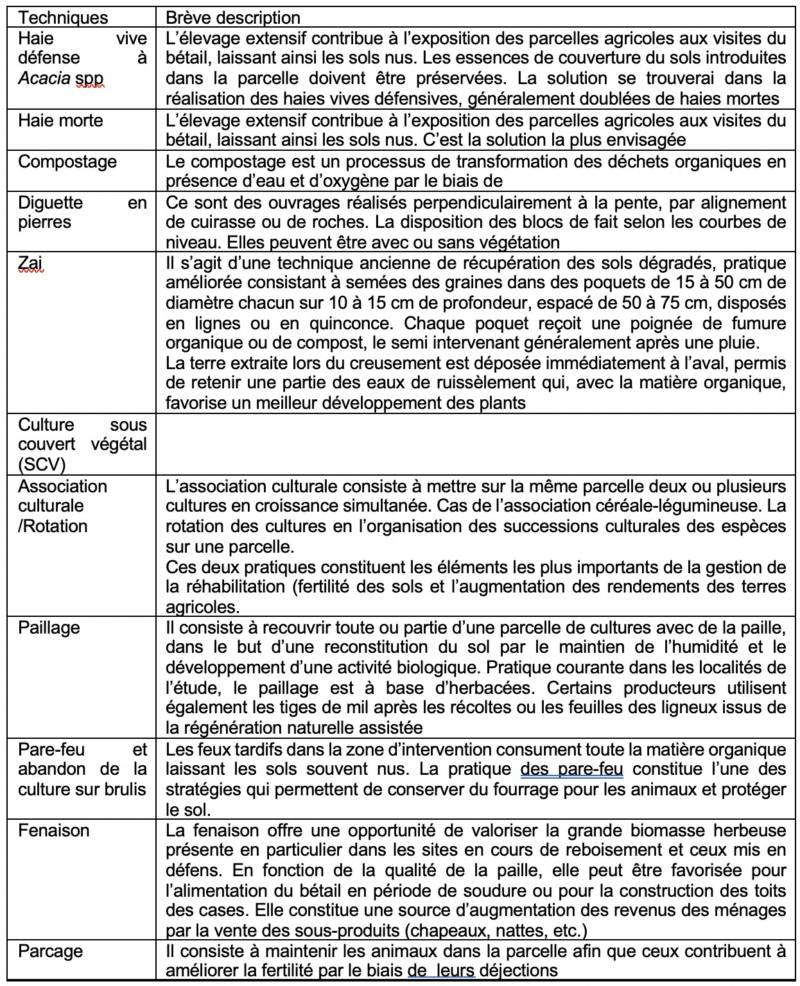
Training of beneficiaries
A total of 95 beneficiaries were trained. These included traditional and religious authorities, administrative authorities, beneficiaries (male, female and young), communal agents and representatives of civil society organizations.
Creation of community school nurseries
With the support of GIZ-ProPFE experts and managers from the Ministry of Forests and Fauna, a total of 79 beneficiaries received technical and managerial capacity building on installation, maintenance and monitoring techniques for nursery plants. The factors that contribute to the achievement of quality seedlings were shared in the working groups. It appears that the quality of the plant depends on: (i) the ability to produce new roots quickly; (ii) the rate at which roots settle in the soil and begin to assimilate and grow after transplanting; (iii) a well-developed root system; (iv) a foliage adapted to the sun; (v) a large diameter at the root neck; (vi) a balanced ratio of rejection to root; and (vii) the availability of good carbohydrate reserves.
Compost production
Approximately 500 Kg to one tonne of compost was produced by the beneficiaries for the 2018 and 2019 agricultural seasons. The advisory support and the provision of small equipment have contributed to these encouraging results.
Composting session in Maoudine
Plant production and distribution
A total of 6,233 and 5,172 plants were produced in 2018 and 2018 respectively. These plants were distributed and planted among community members, taking into account the specific areas of each school plot.
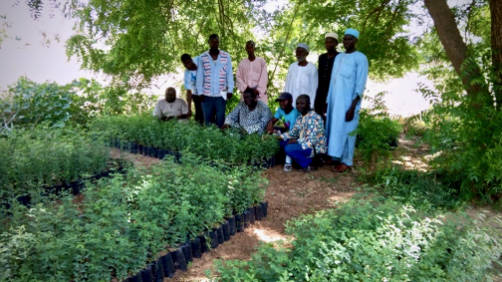
Community school nursery in Maoudine
Accompaniment of beneficiaries to respect the technical itineraries for planting seedlings
Emphasis was placed on the importance of respecting the technical itineraries for planting plants. Practical sessions were administered to Learning by Doing beneficiaries.
Hole (left) and defensive hedge growing in Laf (right)
Choice and roles of land cover species
The importance and role of land cover species. Table 5 below provides a summary of the related information.
Table 5: Characteristics of the main cover crops that will be used in association with farmers’ speculations.
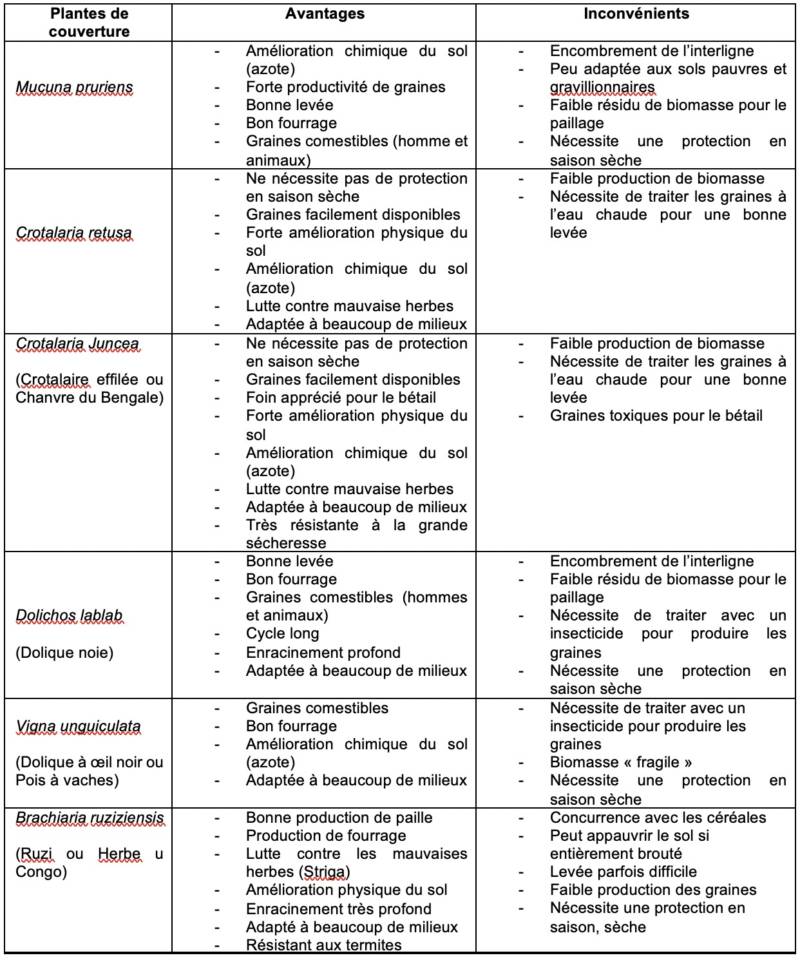
Technical itineraries of the association of ground cover plants with crops
In order to maximize yields, several combinations were made, either for food or cash crops. The period of introduction of ground cover plants was crucial. The plot was subdivided into blocks. Cotton, for example, was associated only with cowpea. Table 6 below presents some associations carried out in a plot in Laf.
Table 6: Characteristics of associations in a school plot in Laf

Combination of cereals with fertilizing legumes or forage species with laf
Yield estimation
The yields for the first year of support (2018) are shown in Table 7. They concern four (04) Leaders Farmers for an area of 6.41 ha. From these yields, the vast majority of the inhabitants demonstrated their enthusiasm for implementing the GOOD PRACTICES learned. This enthusiasm made it possible to enrol 33 other leading farmers, i.e. a total of 37 school plots undergoing rehabilitation, for an area of 22.86 ha for the second year of support, 2019. Thanks to the appropriation of GOOD PRACTICES by the Relay Trainers, a projection was estimated for the third consecutive year corresponding to a scaling up over an area of 50 ha. It is important to mention that the approach was based on consulting support with a degressive grant over three successive years.
Table 7: Summary of yields obtained on the four plots during the 2018 season
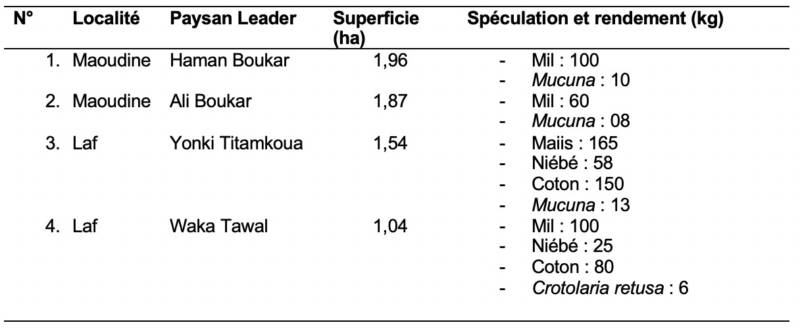
Key Messages
Declining soil fertility leads to low yields among small producers in rural areas. These low yields have a direct impact on food insecurity (malnutrition and famine). There is therefore an urgent need to provide viable land rehabilitation options to help communities improve their well-being and livelihoods. Although this study is still ongoing, the following implications can be suggested. These include:
- Awareness-raising and dissemination actions that can lead farmers and herders towards a change in their practices for greater resilience to the climate
- Local organizations must be oriented towards the development of water and soil management practices adapted to the plot and livestock
- Faced with diverse and varied needs, the production systems of small producers are very complex (combination of various crops (subsistence or cash crops) and small livestock — this complexity requires adapted agricultural innovations
- The capacity of communities to explore practices that reduce water loss and maximize productivity should be strengthened
- It is essential to set up a follow-up of the capacity building mechanism for agricultural advisory support visits for a better dissemination of technologies
References
Abdoussallam S., Dougbedji F.., Bado V.B., Ousmane H., Savadogo P. 2017. Biological recovery of degraded land. A systemic approach to generate income, improve nutrition and empower women economically. Manual for trainers and producers: project to support household food security; ICRISAT, Niamey, Niger, 48p.
Cameroon’s Growth and Employment Strategy Paper (DSCE), 2010
FAO, 2016. Global Forest Resources Assessment 2015; How are the world’s forests changing? 2nd Edition. Rome.
Gilbey B., Davies J., Metternicht G., Magero C. 2019. Taking land degradation neutrality from concept to practice: Early reflections on LDN target setting and planning. Environmental Science and Policy 100/230-237. https://doi.org/10.1016/j.envsci/2019.04.007.
IUCN, Davies J., Gudka M., Laban P., Metternicht G., Alexander S., Hannam I et al. 2015. Land degradation neutrality: implications and opportunities for conservation. Dickhead. Switzerland: IUCN.
MINEPDED, 2015a. National Climate Change Adaptation Plan. 154p.
UNEP, 2013. Global Environment Outlook, Africa. http://wedocs.unep.org/bitstream/handle/20.500.11822/7595/GEO_Africa_201611.pdf?seguence=1&isAllowed=y
Stavi I. Lal R. 2015. Achieving zero net land degradation: Challenges and opportunities. Journal od Arid Environments 112:44-51. https://doi.org/10.1016/j.jaridenv.2014.01.016.
United Nations Convention to Combat Desertification (UNCCD), 2016b. Land degradation neutrality target setting program: A technical guide. Bonn, Germany.
The author
The copy has been provided by Makueti Josephine Thérèse, PhD, email: jospehine.makueti@giz.de

